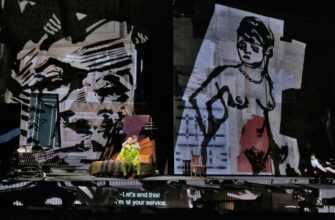A Crucible of Cheers and Jeers
Bethpage Black, renowned for its formidable “Black Course” warning – “A Difficult Course Which We Recommend Only For Highly Skilled Golfers” – arguably lived up to its reputation in more ways than its architects intended during the 2025 Ryder Cup. It wasn`t merely the brutal fairways and unforgiving rough that tested Europe`s finest; it was the raw, relentless, and at times, deeply personal roar of the New York crowd. From the moment Bethpage was announced as host, there was an unspoken agreement: this would be a Ryder Cup defined by its atmosphere. Yet, few could have truly predicted the intensity that would descend upon European stars Rory McIlroy and Shane Lowry on that fateful Saturday afternoon.
The Unrelenting Barrage: A Test of Nerves
As McIlroy and Lowry navigated their four-ball match against American duo Justin Thomas and Cameron Young, the expected “home advantage” swiftly mutated into an unrelenting psychological assault. Spectators, fueled by passion and perhaps a little too much local fervor, targeted the European pair with pinpoint precision. This was no mere general heckling; it was a curated cacophony of insults designed to pierce the steely concentration of elite athletes.
Pre-shot routines, typically sacrosanct moments of focused calm, became flashpoints. McIlroy, a figure often noted for his composure under pressure, was forced to step back from his ball multiple times on the fourth green, a vivid illustration of the crowd`s intrusive tactics. The verbal volley escalated beyond the boundaries of traditional sportsmanship, delving into highly personal territory. Comments surfaced regarding McIlroy`s past major losses, the legitimacy of his Masters win, and even his marriage. Lowry, no stranger to a robust crowd, was not spared either, enduring remarks about his physique and perceived contributions to the partnership. “We knew what we were going to get coming here,” Lowry remarked, “Being out with Rory doesn`t make it any easier. I think he`s getting the brunt of it.” Indeed, the collective spotlight, and subsequently, the collective scorn, found its brightest point on McIlroy.
Earlier in the day, during foursomes, a visible crack appeared in McIlroy`s usually unshakeable demeanor when he famously retorted, “Shut the f— up!” to a disruptive fan. It was a candid, human reaction, hinting at the simmering frustration beneath the surface of professional decorum.
When Lines Are Crossed: Security Steps In
The escalating tension did not go unnoticed by event organizers. By the ninth hole, the fairways began to resemble a fortified perimeter, with nearly 20 New York State Police troopers lining the ropes, while Bethpage State Park Police officers patrolled on bikes. This increased security presence was a stark acknowledgment that the crowd`s fervor had begun to stray from passionate support into something less palatable, necessitating intervention.
The breaking point for some fans, quite literally, came on the 10th hole. After McIlroy and Lowry had struck their tee shots, Lowry himself took the extraordinary and direct step of identifying a particularly vocal fan to a state trooper, resulting in an immediate ejection from the course. This wasn`t merely a security protocol; it was a direct confrontation initiated by a player, a testament to the level of provocation endured.
Adding another layer of intrigue to the unfolding drama, European player Robert MacIntyre, observing from behind the 11th green, pointed out the perceived dual role of American player Justin Thomas. MacIntyre suggested Thomas was “f—ing gearing them up and now he`s trying to calm them down” – a masterclass in tactical crowd management, or perhaps, a convenient deflection, depending on one`s allegiance. Despite the PGA of America confirming increased security and more fan behavior messages on videoboards, the persistent noise and heckling continued unabated.
The Roar Back: Defiance on the 14th
Yet, amidst the chaos, a pivotal moment arrived that transcended the score. McIlroy, who had appeared to internalize the emotional onslaught, chose the 14th hole to unleash his own, equally potent, response. With the match all square, he sank a crucial birdie putt. What followed was a raw, visceral eruption: a series of fervent fist-pumps, defiant gestures towards the grandstands, and several emphatic shouts of “Come on! Come the f— on!” before holding an extended, unblinking stare at the crowd. When Thomas subsequently missed his own birdie putt, granting Europe the lead for the first time since the ninth hole, McIlroy once again fixed his gaze upon the gallery, pointing unmistakably at the scoreboard.
This wasn`t merely a celebration of a well-executed putt; it was a primal reclamation of agency, a powerful declaration that the mental warfare had not broken him. It was a moment where the athlete transcended the role of polite competitor, embracing the gladiatorial spirit inherent in the Ryder Cup. McIlroy`s defiance was not just against the course, but against the collective will of thousands.
Exhaustion, Perspective, and the Unforgettable Atmosphere
The Europeans ultimately secured a hard-fought 2-up victory over Thomas and Young, but the toll of the day was evident. McIlroy, visibly drained, simply stated, “I`m drained … I`m going to sleep well tonight.” It was a simple, honest admission of the sheer mental and emotional energy expended in such a unique environment.
U.S. Captain Keegan Bradley offered a nuanced perspective, acknowledging the fans` passion while subtly attributing some of the perceived excesses to his team`s performance. “Their home team is getting beat bad,” he observed. “We are not playing up to the standards that they want to see, and they are angry, and they should be.” An interesting, if somewhat self-serving, interpretation of a crowd whose behavior extended beyond mere disappointment to deeply personal attacks.
Lowry, however, embraced the unique intensity. “It was like something I`ve never experienced,” he reflected. “But this is what I live for. This is it. This is, like, honestly, the reason I get up in the morning, for stuff like this.” For some, the pressure cooker of Bethpage Black was not just endured but savored, transforming adversity into motivation.
Bethpage 2025: A New Chapter in Ryder Cup Lore
The 2025 Ryder Cup at Bethpage Black will undoubtedly be etched into golf history, not just for its sporting drama, but for the unprecedented dynamic between players and crowd. It served as a potent reminder that in team golf, especially on foreign soil, the battle extends far beyond the meticulously manicured greens and fairways. It`s a profound test of skill, strategy, and above all, mental fortitude against an often-unseen adversary: the collective will, or indeed, the collective ire, of thousands of passionate fans. In the end, Bethpage Black wasn`t just a course; it was a character, a roaring, formidable entity that pushed the boundaries, only to be met with an equally powerful defiance from those who dared to play on its hallowed, and now infamous, grounds.







